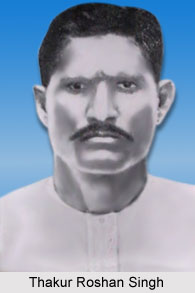 Roshan Singh, also known as Thakur Roshan Singh, was a prominent Indian revolutionary who was earlier sentenced in the Bareilly Goli Kand or Bareilly shooting case, which occurred during the Non-Cooperation Movement during the year 1921 and 1922. He became a member of the Hindustan Republican Association (HRA), which later became the Hindustan Socialist Republican Association (HSRA) in the year 1924, after he was released from Bareilly Central Jail. Even though Singh did not participate in the in the Kakori conspiracy yet, he was detained and imprisoned. After the trial, he was given capital punishment of death sentence by the British authorities of India.
Roshan Singh, also known as Thakur Roshan Singh, was a prominent Indian revolutionary who was earlier sentenced in the Bareilly Goli Kand or Bareilly shooting case, which occurred during the Non-Cooperation Movement during the year 1921 and 1922. He became a member of the Hindustan Republican Association (HRA), which later became the Hindustan Socialist Republican Association (HSRA) in the year 1924, after he was released from Bareilly Central Jail. Even though Singh did not participate in the in the Kakori conspiracy yet, he was detained and imprisoned. After the trial, he was given capital punishment of death sentence by the British authorities of India.
Early Life of Roshan Singh
Roshan Singh was born on 22 Jan 1892 to the parents Jangi Singh and Kaushalya Devi. He was born in a Thakur family of Navada village in Shahjahanpur district of Uttar Pradesh. During his initial years, he played various sports and was a good sharp shooter and wrestler.
Revolutionary Activities of Roshan Singh
Thakur Roshan Singh was been associated with the Arya Samaj of Shahjahanpur for a long period of time. When the British Government of India forced a ban on Indian National Congress Volunteer Corps in November 1921, independence activists opposed the decision of the authorities. Singh led the group of insistent volunteers from the district of Shahjahanpur to the region of Bareilly. The British Indian Police began firing in order to end the procession. Roshan Singh, along with other protesters, were arrested and after the trial, he was sentenced to 2 years rigorous imprisonment in the Central Jail of Bareilly.
After Roshan Singh was released from Bareilly jail, he met with Pandit Ram Prasad Bismil in the grounds of the Arya Samaj at Shahjahanpur. Singh instantly joined the newly established organisation. He was given the responsibility to train shooting to the young members of the party. During that period, the Hindustan Republican Association (HRA) was trying hard to gather funds for their missions. According to the suggestions of Thakur Roshan Singh, Ram Prasad Bismil devised a plan to steal money from the more affluent part of society through armed force and terror. On 25 December 1924, the house of Baldeo Prasad, who was a money lender, was raided by the revolutionaries of Hindustan Republican Association under the leadership of Singh.
Thakur Roshan Singh was later arrested by the British Indian Police in the case of the Kakori train robbery, even though he did not participate in the incident. After the trial, Singh was sentenced to death for the murder of Mohan Lal.



















